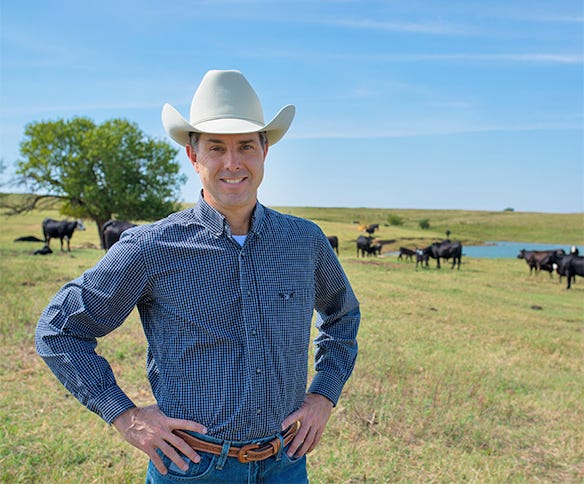For cows it isn't 'go big or go home'
Study of cow size, environment and calf performance shows matching the cow to the environment is key.
November 29, 2017

By Robert Waggener
Editor’s note: This is the fourth story in a series exploring the benefits of fitting the cow to the environment.
Weather conditions played a significant role in the weaning weights of cattle during a four-year study on dryland range in southeast Wyoming.
The results, especially during drought conditions, surprised the research team. However, they determined that cow size and corresponding weaning weights were only one piece of the puzzle when trying to fit the cow to the environment.
Milk production is among the other important factors.
Weather conditions varied widely during the study from 2011 through 2014, replicating what ranchers who graze livestock in dryland pastures and range settings might experience over the long haul.
Intermediate-sized cows weaned the heaviest calves during an average precipitation year; the smallest cows weaned the heaviest calves during a wet year while the largest cows weaned the heaviest calves following a year of extreme drought.
“The results contradicted what we thought would happen during a drought year, that the smaller- to moderate-sized cows would wean heavier calves,” says John Derek Scasta, University of Wyoming Extension range specialist.

MATCHING UP: Match cows to the environment, not the environment to the type of cows you like, suggests Oklahoma State University Extension beef cattle specialist David Lalman.

Scasta believes that the larger cows performed better during drought because of their larger rumen size, but that finding alone is overshadowed by many other factors.
He and fellow researchers David Lalman (Oklahoma State University Extension beef cattle specialist) and Leticia Varelas (Oregon State University Extension livestock and range agent) suggest that ranchers pay attention to cow size, avoiding the extremes of going too big or too small.
“The development of very large cows has crept up on the beef industry over the last several decades, and I believe ranchers should give this some attention,” Scasta says. “Reproductive efficiency, forage intake and overall herd efficiency are really important, and these are factors that producers should be cognizant about and manage toward.”
Size matters
In their study, Scasta says just looking at weaning weights wasn’t always informative, but looking at efficiency arguably became very important.
According to their findings, ranchers should strive to maintain moderate-sized cows with moderate milk production, and neutralize or reverse recent increasing trends in these features due to strong selection of growth genetics and muscling.
“Paying attention to cow size and trying to keep cows moderate to smaller in size could pay dividends in the long run,” Scasta says. “I’ve had people ask: ‘Should we be concerned about going super small with cows?’ My argument is that I would want to avoid going super big, that the largest cows have significantly lower efficiency ratios.”
Scasta adds: “Some of the most successful ranches I am working with today are paying a lot of attention to this very issue.”
Match cow size, milk production to forage resources
Because grazed forage remains the least expensive source of nutrients to maintain the cow herd, optimizing forage utilization and reproductive efficiency can be achieved, in part, by matching cow size and milk production potential to forage resources.
“It’s important to match the cows to the environment. Don’t try to make the environment fit the kind of cows you like,” says Oklahoma State University Extension beef cattle specialist David Lalman.
Breed is part of it, he notes, but his emphasis is on factors that influence annual cow costs. Those include mature cow size, milk production and growth.
“Our forage has a maximum of what it can support,” he says, “and what we have done with some characteristics — milk in particular — has led to the development of cows that have more genetic potential than our forage can support.”
In addition to this, Lalman notes, “Aggressive selection for growth and milk increases appetite and maintenance energy requirements, and both of these increase annual cow costs.”
Commercial producers having really high quality forage four or five months out of the year could probably stand a moderate level of milk, he continues.
But producers having high quality forage for only two months will be left with 10 months where the forage can’t support the genetic potential of the cow.
“As input costs have gone up, I really can’t find an environment that can support an extreme high level of milk production in beef cows,” Lalman says.
Study shows no advantage to larger cows
How did weather affect weaning weights during the four-year study on dryland range near Laramie, Wyo.?
• In 2011, an average precipitation year, the intermediate-sized cows (those weighing around 1,200 pounds) weaned the heaviest calves.
• In 2012, during an extreme drought, the largest cows (around 1,400 pounds) weaned the heaviest calves.
• In 2014, an abnormally wet year, the smallest cows (around 1,000 pounds) weaned the heaviest calves.
• Across the dry-wet gradient, there were no statistical advantages to larger cows in terms of weaning weight or efficiency.
You May Also Like
.png?width=300&auto=webp&quality=80&disable=upscale)


